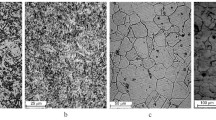Abstract
Using the energetic approach, we generalize the influence of the main external service factors (mechanical, chemical, and thermal) on the change in the initial properties of structural materials. Temperature ranges of embrittlement are investigated for a number of austenitic steels and alloys in gaseous hydrogen under high pressure. We give recommendations on the proper choice of the structure and composition of structural materials operating in hydrogen according to a given cyclogram of the article. Practical examples demonstrating how to use these recommendations are presented.
Similar content being viewed by others
References
R. A. Oriani, “A mechanistic theory of hydrogen embrittlement of steels,”Ber. Bunsenges, Phys. Chem., No. 8, 818–858 (1972).
C. A. Zappfe, “Hydrogen theory for brittle ship plate,”Met. Progr. 39, No. 6, 802–808 (1941).
D. G. Westlake, “Equilibrium aspects of hydrogen embrittlement of steels,”Trans. ASM 62, 1000–1006 (1969).
B. B. Panasiuk, A. Ye. Andreykiv, and B. S. Kharin. “Model of crack growth in deformed metals under the action of hydrogen,”Fiz.-Khim. Mekh. Mater., No. 2, 3–17 (1987).
B. A. Kolatchev,Hydrogen Brittleness of Metals [in Russian], Metallurgiya, Moscow (1985).
V. I. Shapovalov,Effect of Hydrogen on the Structure and Properties of Iron-Carbon Alloys [in Russian], Metallurgiya, Moscow (1982).
N. A. Galaktionova,Hydrogen in Metals [in Russian], Metallurgiya, Moscow (1967).
A. P. Gulyayev,Metal Science [in Russian], Metallurgiya, Moscow (1986).
V. M. Katlinskii, “Investigation of diffusion in hydride phases of metals from the titanium subgroup,”Izv. Akad. Nauk SSSR. Neorg. Mater. 14, No. 9, 1674–1677 (1978).
P. V. Geld, V. A. Ryabov, and E. S. Kodes,Hydrogen and Irregularities of Metal Structure [in Russian], Metallurgiya, Moscow (1979).
M. M. Shved,Effect of Hydrogen on the Service Properties of Iron and Steel [in Russian], Naukova Dumka, Kiev (1985).
V. I. Mikheyeva,Hydrides of Transient Metals [in Russian], Izd. Akad. Nauk SSSR, Moscow (1960).
P. G. Shewmon, “Hydrogen attack of carbon steel,”Met. Trans. 7A, No. 2, 279–286 (1976).
Yu. I. Archaksov,Hydogen Corrosion of Steel [in Russian], Metallurgiya, Moscow (1985).
V. V. Kuznetsov, N. I. Subbotina, and G. V. Khaldeyev, “Changes in the dislocation structure of ferrosilicon under hydrogenation in an ultrasonic field,” [in Russian],Fiz.-Khim. Mekh. Mater., No. 3, 97–98 (1974).
F. Kazinczy, “Effect of hydrogen on the yielding of mild steel,”Acta Met. 7, No. 11, 706–708 (1959).
L. S. Moroz and B. B. Chechulin,Hydrogen Brittleness of Metals [in Russian], Metallurgiya, Moscow (1967).
Advances of Corrosion Science and Corrosion Protection. Corrosion Cracking of Metals [Russian translation], M. Fontaine and R. Stale (eds.), Metallurgiya, Moscow (1985).
Additional information
Karpenko Physicomechanical Institute, Ukrainian Academy of Sciences, L'viv. Translated from Fiziko-Khimicheskaya Mekhanika Materialov, Vol. 29, No. 5, pp. 15–24, September–October, 1993.
Rights and permissions
About this article
Cite this article
Tretyak, I.Y. Interaction of high-alloy steels and alloys with hydrogen under conditions close to operating. Mater Sci 29, 446–454 (1994). https://doi.org/10.1007/BF00558763
Received:
Issue Date:
DOI: https://doi.org/10.1007/BF00558763




